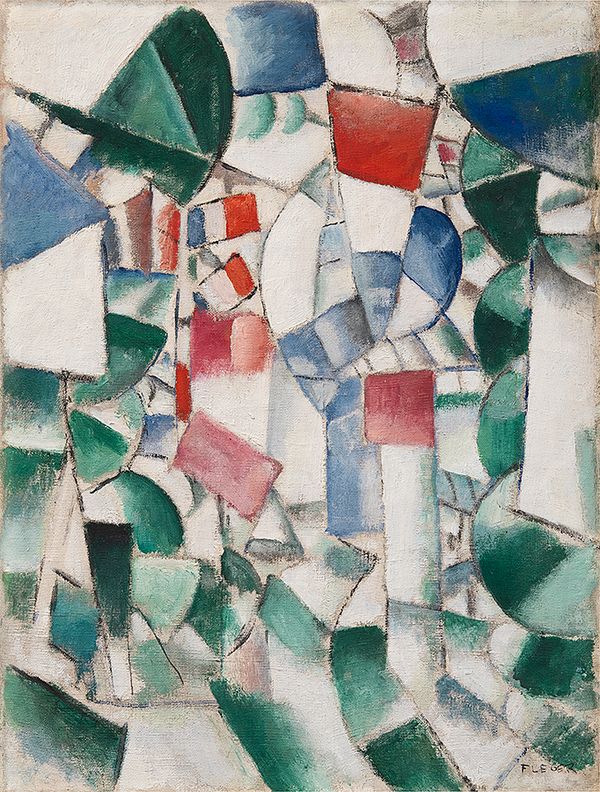Fernand Léger, Le 14 juillet, c. 1912–1913. Living the Avant-Garde: The Triton Collection Foundation.
—Written by Izzy DeSantis, Researcher/Writer, Evening Sale
Living the Avant-Garde: The Triton Collection Foundation brings together thirty masterworks from the course of art history. These works span a century of innovation in the visual arts, and represent the key artists and movements that define our contemporary understandings of art and artistry. The Triton Collection Foundation gathered together this impressive group over the course of forty years, a testament to the discernment and commitment of the collectors, and the art historical significance of each individual work. The online catalogue provides novel art historical insights and important context for each artwork from the Triton Collection Foundation.
The Nabis
Émile Bernard, Paysage de Bretagne (Paysage avec deux Bretonnes et vache), 1892. Living the Avant-Garde: The Triton Collection Foundation.
The collection begins with an exemplary selection of works by the Nabis, a group of young, avant-garde painters working out of Pont Aven and Paris in the late 1880s to early 1890s. These Nabis works are some of the finest to come to market in recent years, and each is a quintessential representation of the stylistic innovations developed by the group. From Paul Sérusier’s magnificent, shaped canvas, La Cueillette des Pommes, 1891, to Émile Bernard’s pastoral Paysage de Bretagne, 1892, the Nabis works in Living the Avant-Garde: The Triton Collection Foundation express the rich collaborative spirit and bright aesthetic sensibility of these avant-garde artists.
Cubist Masterworks
Pablo Picasso, Femme en corset lisant un livre, c. 1914–1918. Living the Avant-Garde: The Triton Collection Foundation.
Works by Georges Braque, Pablo Picasso, and Fernand Léger form a trifecta of Cubist masterpieces, with Braque’s La bouteille de Bass, 1911-1912, as a stunning example of Analytic Cubism from the artist’s period of close collaboration with Picasso. The latter’s Femme en corset lisant un livre, c. 1914-1918, develops one of Picasso’s signature motifs, the seated female figure, through the lens of one of his earliest muses, Eva Goeul. Synthesizing Cubism together with attendant early 20th century art movements in his unique visual idiom, Léger’s double-sided Le 14 juillet, c. 1912-1913, is an exciting record of the ever-evolving avant-garde of the early 20th century. Indeed, the entire pre-World War I European avant-garde is well represented in Living the Avant-Garde: The Triton Collection Foundation, with excellent pieces by the leading artists of the most important movements of the era, including Die Brücke, Der Blaue Reiter, Futurism, and de Stijl.
Post-War Art
Joan Mitchell, Untitled, c. 1953. Living the Avant-Garde: The Triton Collection Foundation.
In the Post-War passage of the collection, both European and American strands of the avant-garde hold their own. There are fine examples of the monochromatic experiments of Yves Klein, Piero Manzoni, and Robert Ryman; Joan Mitchell’s monumental Untitled, c. 1953, stands as a bastion of Abstract Expressionism in dialogue with the Paris-based Lyrical Abstractions of Sam Francis and Jean-Paul Riopelle. Alexander Calder and Louise Bourgeois represent innovations in Post-War sculpture, while Jean Dubuffet’s Inspecteurs Sinoque et Dingue, 1967, both reflects back on art brut and anticipates the role of street art and graffiti on contemporary art practice. The work of Roy Lichtenstein brings the collection to the end of the 20th century, and looks forward to the innovations to come. The Triton Collection Foundation is a living collection, tracing the avant-garde through its contemporary iterations.
Discover More from Living the Avant-Garde: The Triton Collection Foundation >



